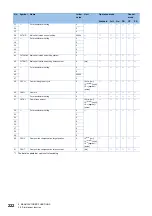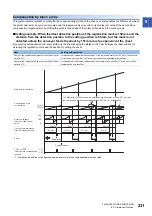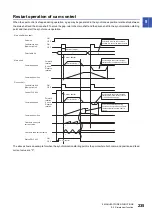
232
9 MANUFACTURER FUNCTIONS
9.5 Simple cam function
Details of cam position compensation
This function compensates the difference between the target and actual sensor detection positions by shifting the cam axis
current value per cycle. The cam axis length per cycle (sheet length) after compensation (ccyl') is calculated as follows:
CCYL: Cam axis length per cycle ([Cam control data No. 48])
CPHV: Cam position compensation target position ([Cam control data No. 60])
ccyl': Cam axis one cycle length (after compensation)
cpos: Cam axis current value per cycle at sensor detection
CPHV - cpos: Distance between the target and actual sensor detection positions
• When the sensor detection position is before the target position (CPHV
≥
cpos): ccyl' = CCYL - (CPHV - cpos)
The difference (CPHV - cpos) is added to the cam axis current value per cycle to increase the conveyor travel distance. The
filter time constant for acceleration/deceleration at compensation can be adjusted with [Cam control data No. 61 Cam position
compensation time constant].
• When the sensor detection position is after the target position (CPHV < cpos): ccyl' = CCYL + (cpos - CPHV)
The difference (cpos - CPHV) is subtracted from the cam axis current value per cycle to decrease the conveyor travel
distance. The filter time constant for acceleration/deceleration at compensation can be adjusted with [Cam control data No. 61
Cam position compensation time constant].
CPHV - cpos
ccyl'
cpos
Sheet
Cam axis one cycle
current value
CPHV ([Cam control data No. 60])
CCYL ([Cam control data No. 48])
cpos - CPHV
ccyl'
cpos
Sheet
Cam axis one cycle
current value
CPHV ([Cam control data No. 60])
CCYL ([Cam control data No. 48])
















































